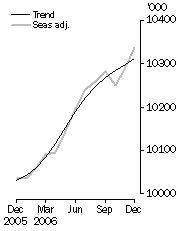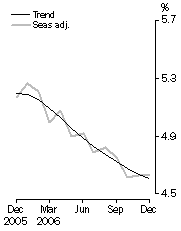DECEMBER KEY FIGURES
 |  | Nov 2006 | Dec 2006 | Nov 06 to Dec 06 | Dec 05 to Dec 06 |
|
| Trend |  |  |  |  |  |  |
 | Employed persons ('000) | 10 299.6 | 10 311.1 | 11.5 |  | 2.8 | % |
 | Unemployed persons ('000) | 501.2 | 498.0 | -3.2 |  | -9.4 | % |
 | Unemployment rate (%) | 4.6 | 4.6 | 0.0 | pts | -0.6 | pts |
 | Participation rate (%) | 64.9 | 64.8 | 0.0 | pts | 0.4 | pts |
| Seasonally Adjusted |  |  |  |  |  |  |
 | Employed persons ('000) | 10 292.7 | 10 337.3 | 44.6 |  | 3.0 | % |
 | Unemployed persons ('000) | 499.6 | 501.8 | 2.3 |  | -8.2 | % |
 | Unemployment rate (%) | 4.6 | 4.6 | 0.0 | pts | -0.5 | pts |
 | Participation rate (%) | 64.8 | 64.9 | 0.2 | pts | 0.6 | pts |
|
Employed Persons

| Unemployment rate

|
DECEMBER KEY POINTS
TREND ESTIMATES (MONTHLY CHANGE)
- EMPLOYMENT increased to 10,311,100
- UNEMPLOYMENT decreased to 498,000
- UNEMPLOYMENT RATE remained at 4.6%
- PARTICIPATION RATE remained at 64.8%
SEASONALLY ADJUSTED ESTIMATES (MONTHLY CHANGE)
EMPLOYMENT
- increased by 44,600 to 10,337,300. Full-time employment increased by 17,700 to 7,382,200 and part-time employment increased by 26,900 to 2,955,100.
UNEMPLOYMENT
- increased by 2,300 to 501,800. The number of persons looking for full-time work increased by 1,400 to 359,500 and the number of persons looking for part-time work increased marginally to 142,400.
UNEMPLOYMENT RATE
- remained at 4.6%. The male unemployment rate decreased by 0.2 percentage points to 4.4% and the female unemployment rate increased by 0.2 percentage points to 5.0%.
PARTICIPATION RATE
- increased by 0.2 percentage points to 64.9%.
NOTES
FORTHCOMING ISSUES
| ISSUE | Release Date |
| January 2007 | 8 February 2007 |
| February 2007 | 15 March 2007 |
| March 2007 | 12 April 2007 |
| April 2007 | 10 May 2007 |
| May 2007 | 7 June 2007 |
| June 2007 | 12 July 2007 |
POPULATION BENCHMARKS
Labour Force Survey (LFS) estimates are calculated in such a way as to add up to independent estimates of the civilian population aged 15 years and over (population benchmarks). These population benchmarks are projections of the most recently released quarterly Estimated Resident Population (ERP) data. For information on the methodology used to produce the population benchmarks see paragraph 10 of the Explanatory Notes.
In October, November and December 2006 the population benchmarks increased by 29,100 each month. This increase was larger than the average monthly increase over the previous 12 months, reflecting larger than expected growth in the revised ERP estimates published in the March quarter 2006 issue of Australian Demographic Statistics Quarterly (cat. no. 3101.0). The higher benchmarks have resulted in a small upward impact on estimated employment growth over the period October, November and December 2006.
SAMPLING ERRORS
The estimates in this publication are based on a sample survey. Because the entire population is not enumerated, the published estimates and the movements derived from them are subject to sampling variability. Standard errors give a measure of this variability and appear on pages 28 and 29.
The 95% confidence intervals below provide another way of looking at the variability inherent in estimates from sample surveys. The interval bounded by the two limits is the 95% confidence interval. A 95% confidence interval has a 95% chance of including the true value of the estimate.
Movements in seasonally adjusted series between November and December 2006 |
|  |
 | Monthly change | 95% Confidence interval |  |
 |  |  |  |  |  |
|  |
| Total Employment | 44 600 | -8 400 | to | 97 600 |  |
| Total Unemployment | 2 300 | -24 500 | to | 29 100 |  |
| Unemployment rate | 0.0 pts | -0.2 pts | to | 0.2 pts |  |
| Participation rate | 0.2 pts | -0.2 pts | to | 0.6 pts |  |
|  |
INQUIRIES
For further information about these and related statistics, contact the National Information and Referral Service on 1300 135 070 or Bjorn Jarvis on Canberra (02) 6252 6525.
 Print Page
Print Page
 Print All
Print All